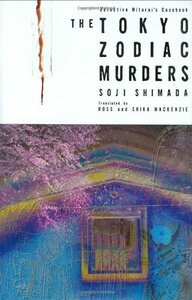Take a photo of a barcode or cover
I totally picked up this book for its cover, which I think is a lot more edgy than the book itself. Shimada has written a kind of Holmes pastiche, where the first third of the book or so is literally two characters talking over a long dead mystery, with an aim to solve it, and this was kind of slow going-- what worked for Holmes and Watson doesn't quite hum along today the way it did in the nineteenth century, and the weight of detail here made the first part of the book kind of lumbering.
Later sections, when the two main characters got out and about worked better for me, and there was some fun sociological stuff about Japan in here, and they did become kind of funny and rich to me as characters. The detective story is that type where readers get all the clues before the curtain is pulled back, and there are mildly postmodern elements in this novel, including the author addressing us (twice) to tell us we can solve the murder now.... There were formal disruptions in spots throughout the book that made me want to read Shimada in a more unrestrained narrative than this one.
Cool cover, though, and I am interested in the Pushkin Vertigo line of books that this came from.
Later sections, when the two main characters got out and about worked better for me, and there was some fun sociological stuff about Japan in here, and they did become kind of funny and rich to me as characters. The detective story is that type where readers get all the clues before the curtain is pulled back, and there are mildly postmodern elements in this novel, including the author addressing us (twice) to tell us we can solve the murder now.... There were formal disruptions in spots throughout the book that made me want to read Shimada in a more unrestrained narrative than this one.
Cool cover, though, and I am interested in the Pushkin Vertigo line of books that this came from.
dark
emotional
mysterious
slow-paced
adventurous
dark
tense
medium-paced
Plot or Character Driven:
Plot
Strong character development:
No
Loveable characters:
No
Diverse cast of characters:
No
Flaws of characters a main focus:
No
challenging
mysterious
reflective
medium-paced
Plot or Character Driven:
Plot
Strong character development:
Complicated
Loveable characters:
Complicated
Diverse cast of characters:
No
Flaws of characters a main focus:
No
Here’s a challenge to aspiring writers: make the first character your readers meet a lunatic confessional astrologist painter whose last will and testament includes the details of a plot to murder his six virginal daughters and nieces and dismember their bodies in order to create a perfect woman. Give him some creepy backstory–let’s say he tells us about this one time when he literally fell in love with a mannequin in a shop window, and maybe throw in a suggestion of rape when he talks about how he ended up with his second wife. Add a touch of megalomania. Then have the whole thing translated into another language, preferably one with a different alphabet from your own. See how many of your readers are sticking around after all that.
To read the rest of the review: https://ellethinks.wordpress.com/2015/10/15/the-tokyo-zodiac-murders-by-soji-shimada/
To read the rest of the review: https://ellethinks.wordpress.com/2015/10/15/the-tokyo-zodiac-murders-by-soji-shimada/
This is a fun (although gruesome, which can be part of the fun) puzzle mystery, as sleuths in two timelines attempt to solve an infamous locked room mystery and its aftermath in 1930s Japan. The setting of the original murder, of course, is steeped in 1930s mores, and the growing military tensions with Korea and China, as well as the clash of women's increasing freedom vs. the rigid expectations of the conservative society. When a reclusive (and frankly asshole victim, obsessed with mannequins and all the young women in his family) is found murdered in his locked studio, authorities are baffled, especially after all those young women are found dismembered and placed in a classic labored serial killer astrological pattern AFTER his death. WWII intervenes, and it is only in the 1970s that an amateur detective sets out with fresh eyes to unravel the plot.
I am reading this for "Locked Room Mystery": The Tokyo Zodiac Murders by Soji Shimada. This apparently is a locked room mystery novel that has been getting rave reviews.
Wow all I have to say is that this book was great. More than anything I love clever books like this, and this was definitely very clever. I honestly was a bit worried for a couple of minutes that maybe I wouldn't be able to get the book since the setting is in Japan. But wow the author Soji Shimada is able to pretty much show you that murder is murder no matter where it takes place.
This book is broken into two time periods. The first is Japan in 1936 and the second time period is Japan in 1979.
In 1936, we are treated to a letter that is left by an artist named Heikichi Umezawa. Umezawa wants to "build" the perfect woman. We read of his obsession with women and their bodies as well as his comments on astrology. We realize that he plans on doing away with his children, stepchildren, and nieces (all female) and using parts of them to build his perfect woman and bring Japan back into a state of harmony.
Oh here's the problem, Heikichi Umezawa is found murdered in a locked room. Yet the murders still take place. Who could have decided to follow Umezawa's plan?
When we are back in1979 we follow two amateur detectives (Kiyoshi Mitari and Kazumi Ishioka) our Sherlock and Dr. Watson if you will. FYI that would tick Mitari off since he had some hilarious bad opinions about Sherlock. We find out that the murders are famous in Japan and many people have tried to figure out who killed the women after Umezawa was dead where the perfect woman was left. Just like Sherlock, Mitari is subject to depression, and Kazumi is hoping that the puzzle of the Tokyo Zodiac Murders will drag him out of his depression.
I was fascinated with Mitari since he is a respected astrologer and fortune teller. It seems an odd hobby for our amateur detective, but it makes sense when you get into the astrology aspect of this book.
There are a lot of characters in this one, but I was able to keep them straight. The author provides you the names of everyone up front and throughout the book. We really only get Kazumi's deductions and point of view since he is telling us the story. We do get glimpses of what drives Mitari though.
I loved the writing. Reading about headless corpses that were dismembered repeatedly may not be your thing, so be forewarned. The flow was great too. I also applauded the author for including illustrations of the locked room, and diagrams of other rooms, as well as the corpses being dismembered, and also people's names to family trees, etc. There are a lot of really good illustrations in this book and it made it for me, into a five-star read.
I will say that aspects of this story just thrilled me from beginning to end. Trying to work out how Umezawa was murdered and how an unexpected snowfall came into play was great.
I also loved thinking of Kyoto and cherry blossoms.
The reveal of who the murder was and how they carried it off was brilliant. I would imagine that Dame Agatha would have given this author kudos. Because once this was revealed I had to go back and re-read the clues that were spread throughout the book.
Wow all I have to say is that this book was great. More than anything I love clever books like this, and this was definitely very clever. I honestly was a bit worried for a couple of minutes that maybe I wouldn't be able to get the book since the setting is in Japan. But wow the author Soji Shimada is able to pretty much show you that murder is murder no matter where it takes place.
This book is broken into two time periods. The first is Japan in 1936 and the second time period is Japan in 1979.
In 1936, we are treated to a letter that is left by an artist named Heikichi Umezawa. Umezawa wants to "build" the perfect woman. We read of his obsession with women and their bodies as well as his comments on astrology. We realize that he plans on doing away with his children, stepchildren, and nieces (all female) and using parts of them to build his perfect woman and bring Japan back into a state of harmony.
Oh here's the problem, Heikichi Umezawa is found murdered in a locked room. Yet the murders still take place. Who could have decided to follow Umezawa's plan?
When we are back in1979 we follow two amateur detectives (Kiyoshi Mitari and Kazumi Ishioka) our Sherlock and Dr. Watson if you will. FYI that would tick Mitari off since he had some hilarious bad opinions about Sherlock. We find out that the murders are famous in Japan and many people have tried to figure out who killed the women after Umezawa was dead where the perfect woman was left. Just like Sherlock, Mitari is subject to depression, and Kazumi is hoping that the puzzle of the Tokyo Zodiac Murders will drag him out of his depression.
I was fascinated with Mitari since he is a respected astrologer and fortune teller. It seems an odd hobby for our amateur detective, but it makes sense when you get into the astrology aspect of this book.
There are a lot of characters in this one, but I was able to keep them straight. The author provides you the names of everyone up front and throughout the book. We really only get Kazumi's deductions and point of view since he is telling us the story. We do get glimpses of what drives Mitari though.
I loved the writing. Reading about headless corpses that were dismembered repeatedly may not be your thing, so be forewarned. The flow was great too. I also applauded the author for including illustrations of the locked room, and diagrams of other rooms, as well as the corpses being dismembered, and also people's names to family trees, etc. There are a lot of really good illustrations in this book and it made it for me, into a five-star read.
I will say that aspects of this story just thrilled me from beginning to end. Trying to work out how Umezawa was murdered and how an unexpected snowfall came into play was great.
I also loved thinking of Kyoto and cherry blossoms.
The reveal of who the murder was and how they carried it off was brilliant. I would imagine that Dame Agatha would have given this author kudos. Because once this was revealed I had to go back and re-read the clues that were spread throughout the book.
adventurous
challenging
dark
tense
medium-paced
Plot or Character Driven:
A mix
Strong character development:
Complicated
Loveable characters:
Yes
Diverse cast of characters:
Yes
Flaws of characters a main focus:
No
The narrator, Kazumi Ishioka, plays a Japanese John Watson to Kiyoshi Mitarai’s Japanese Sherlock Holmes, more or less. They are an entertaining duo of amateur detectives trying to solve the 40 year old mystery of a gruesome and highly publicized serial murder.
One fun little twist after the “investigation” is complete but before Kiyoshi reveals the plot, the author breaks the 4th wall and challenges the reader to solve the mystery before he reveals it! About 4/5 of the way through. That’s a mechanism I’ve never seen before, even if we’re all typically doing that when we read mystery novels anyway, and I thought it was a fun little surprise. Also, the mystery puzzle presented was fairly difficult, if I may say so, though I ended up with the right answer on my guess (was definitely not 100% confident), I didn’t figure out all of the clues the story left.
One fun little twist after the “investigation” is complete but before Kiyoshi reveals the plot, the author breaks the 4th wall and challenges the reader to solve the mystery before he reveals it! About 4/5 of the way through. That’s a mechanism I’ve never seen before, even if we’re all typically doing that when we read mystery novels anyway, and I thought it was a fun little surprise. Also, the mystery puzzle presented was fairly difficult, if I may say so, though I ended up with the right answer on my guess (was definitely not 100% confident), I didn’t figure out all of the clues the story left.






